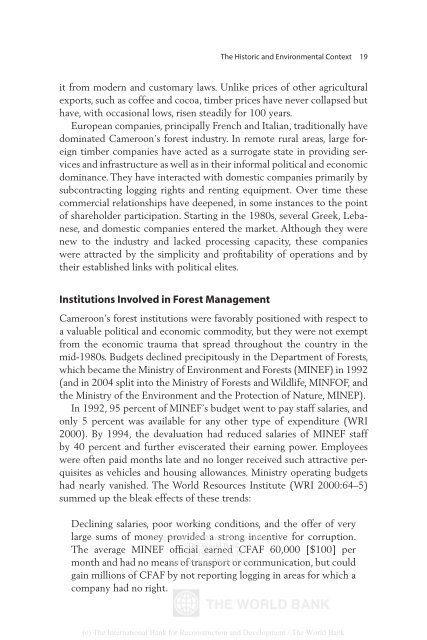The Rainforests of Cameroon - PROFOR
The Rainforests of Cameroon - PROFOR
The Rainforests of Cameroon - PROFOR
- No tags were found...
You also want an ePaper? Increase the reach of your titles
YUMPU automatically turns print PDFs into web optimized ePapers that Google loves.
<strong>The</strong> Historic and Environmental Context 19it from modern and customary laws. Unlike prices <strong>of</strong> other agriculturalexports, such as c<strong>of</strong>fee and cocoa, timber prices have never collapsed buthave, with occasional lows, risen steadily for 100 years.European companies, principally French and Italian, traditionally havedominated <strong>Cameroon</strong>’s forest industry. In remote rural areas, large foreigntimber companies have acted as a surrogate state in providing servicesand infrastructure as well as in their informal political and economicdominance. <strong>The</strong>y have interacted with domestic companies primarily bysubcontracting logging rights and renting equipment. Over time thesecommercial relationships have deepened, in some instances to the point<strong>of</strong> shareholder participation. Starting in the 1980s, several Greek, Lebanese,and domestic companies entered the market. Although they werenew to the industry and lacked processing capacity, these companieswere attracted by the simplicity and pr<strong>of</strong>itability <strong>of</strong> operations and bytheir established links with political elites.Institutions Involved in Forest Management<strong>Cameroon</strong>’s forest institutions were favorably positioned with respect toa valuable political and economic commodity, but they were not exemptfrom the economic trauma that spread throughout the country in themid-1980s. Budgets declined precipitously in the Department <strong>of</strong> Forests,which became the Ministry <strong>of</strong> Environment and Forests (MINEF) in 1992(and in 2004 split into the Ministry <strong>of</strong> Forests and Wildlife, MINFOF, andthe Ministry <strong>of</strong> the Environment and the Protection <strong>of</strong> Nature, MINEP).In 1992, 95 percent <strong>of</strong> MINEF’s budget went to pay staff salaries, andonly 5 percent was available for any other type <strong>of</strong> expenditure (WRI2000). By 1994, the devaluation had reduced salaries <strong>of</strong> MINEF staffby 40 percent and further eviscerated their earning power. Employeeswere <strong>of</strong>ten paid months late and no longer received such attractive perquisitesas vehicles and housing allowances. Ministry operating budgetshad nearly vanished. <strong>The</strong> World Resources Institute (WRI 2000:64–5)summed up the bleak effects <strong>of</strong> these trends:Declining salaries, poor working conditions, and the <strong>of</strong>fer <strong>of</strong> verylarge sums <strong>of</strong> money Delivered provided by <strong>The</strong> World a strong Bank e-library incentive to: for corruption.<strong>The</strong> World Bank<strong>The</strong> average MINEF <strong>of</strong>ficial IP : 192.86.100.34 earned CFAF 60,000 [$100] permonth and had no means Mon, <strong>of</strong> 09 transport Nov 2009 17:06:18 or communication, but couldgain millions <strong>of</strong> CFAF by not reporting logging in areas for which acompany had no right.(c) <strong>The</strong> International Bank for Reconstruction and Development / <strong>The</strong> World Bank
















